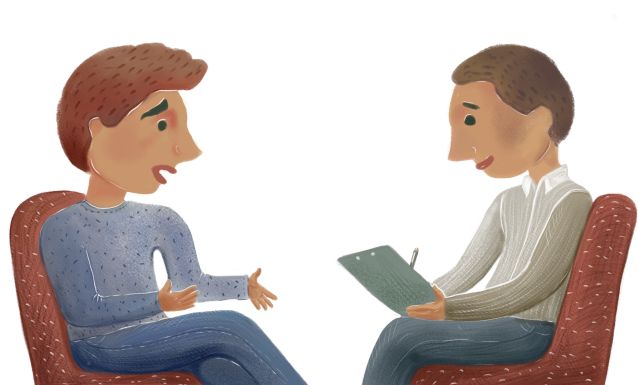Self-Talk
Taming the Critic Within
Therapeutic pathways to transform the inner critic.
Updated February 26, 2024 Reviewed by Abigail Fagan
Key points
- Confronting a harsh inner critic involves distinguishing its unkind voice.
- Memory reconsolidation challenges fixed memories. Revisiting the past from the present can transform memories.
- Enactment of the disjoined aspects of the self reduces self-criticism and boosts self-compassion.
Self‐criticism involves a self-to-self relationship where the dominating aspect of the self, the inner critic, clashes with the more adaptive self-aspect experiencer, hindering its full expression.
The inner critical voice originates outside the self and becomes internalized in childhood as a strategy to navigate challenging environments, and does not simply dissipate with time. Instead, it endures, shaping self-perception even in adulthood, generating automatic negative thoughts that foster anxious and depressive moods. People tend to be markedly influenced by beliefs and emotional tendencies formed early in life, facing challenges in updating or modifying them. However, even though a harsh inner critic may have been a lifelong companion, it is possible to integrate it into the inner system. Nonetheless, the ongoing process of integrating disjoined aspects of the self and resolving the tension between them requires deliberate and continuous actions.
Developing Awareness
The first step is developing awareness of the inner critic, distinguishing between its unfriendly voice and the softer voice of the experiencer. Afterward, recognizing that negative thoughts are only a fraction of their identity, individuals must learn to separate themselves from the inner critic, acknowledging that they also possess a vulnerable self-aspect that feels the impact of criticism.
However, gaining awareness, though therapeutic, is just the initial step. Insight into the inner critic's patterning alone doesn't prompt change; it results in intellectual insight into one's history. The inner critic's diligent protection of vulnerability, shaped by childhood events, underscores the need for exploring early experiences. Understandably, returning to painful events from the past can be daunting. Many people adopt a defensive stance regarding their childhood experiences, expressing sentiments such as, "Why dwell on the past? We should just move forward." While changing the past is beyond reach, however, healing the psyche and prompting the inner critic's shift from a defensive role to a healthier one requires delving into the experiences from early life. Specifically, the past can be resolved by transforming memories, where the memory is reframed as a creative act from the 'here and now,' rather than a static record of events.
Memory Reconsolidation

Memory reconsolidation challenges the notion that memories are fixed. Instead, memories are dynamic and constantly changing. When old memories are triggered, they become open to modification. Engaging in new experiences and revisiting early memories from the present perspective allows reframing existing memories, fostering a profound shift in both understanding and emotional response to past experiences. For example, as we reimagine past situations involving criticism, rejection, and abandonment, assertively confronting these scenarios from our present perspective allows us to craft a new ending to events that unfolded during childhood. This deliberate process reframes the original narrative, assimilating into our memory distinctly different from the original.
The Safety of Another
Due to the inherent inclination of the human psyche to avoid pain, it is challenging for people to confront their emotional pain on their own. This is where the potency of working with the inner critic in therapy becomes evident. When left to our own devices, we frequently encounter barriers — our ingrained methods of distraction from painful emotions. Instead of directly facing the painful emotion, we tend to distract ourselves by working, eating, shopping, or drinking.
Instead, facing the pain in the compassionate presence of another creates a safer environment to endure the pain. A therapist helps the client to stimulate new insights into internal self-to-self relationships and through empathic resonance process emotions. The therapist keeps the individual focused on the pain, yet the client isn't traversing to the painful places alone. Through the therapist's consistent empathic stance and soothing behaviors directed toward the client, a modeling process takes place. Over time, these behaviors are gradually transferred to the client, fostering the development of self-soothing abilities that persist beyond the conclusion of therapy.

Enactment for Emotional Transformation
Different forms of therapeutic interventions exist, aiming to equip people with problem-solving skills, facilitate a re-evaluation of their thoughts, and create opportunities for exploring emotions. Nevertheless, individuals with harsh inner critics may not do as well with conventional therapeutic approaches. This is because the inner critic is very resilient to change.
Emotion-focused two-chair dialogue is recognized as a powerful technique for resolving the tension between the disjoined aspects of the self. Two-chair dialogue has helped people with high levels of self‐criticism increase their self-compassion and self-reassuring capacities, and reduce self-criticism, anxiety, and depressive symptoms. In the two-chair dialogue, resolving the conflict between disjointed aspects of the self involves giving a 'voice' to each side. Each side possesses unique cognitions, emotions, needs, and wants, necessitating their access and enactment for conflict resolution. Consequently, guided by a therapist, the client articulates and embodies the emotions of each side. This entails starting an actual dialogue between the internal aspects of the self. The client begins by taking a seat in one chair, embodying and expressing the inner critic's perspective. They then move to the other chair, embodying the experiencing aspect of the self and expressing thoughts and feelings from that standpoint.
Through the two-chair dialogue, each of these sides is undergoing a different change process. For example, the inner critic is developing compassion and understanding, whereas the experiencer is developing resiliency and assertiveness. This active engagement reshapes how these internal aspects perceive themselves, interact with each other, and ultimately resolves their conflict. Through this approach, individuals move beyond merely discussing and intellectually understanding the conflict between the sides. Instead, they embody and express the different aspects of the self, in that way undergoing a genuine emotional transformation and integration.
Positive Outcomes
As the process in therapy evolves, individuals begin to discern the link between their self-critical process and subsequent negative reactions. A new perspective emerges, revealing self-criticism as an internalized message of the past. The sense of being judged by others transforms into an attribution of one’s criticism onto them. Unresolved anger or sadness surfaces, unmet needs come to light, and individuals either hold others accountable or find forgiveness. The focus shifts from depressive symptoms and hopelessness to the connection between their adaptive responses and their development of new narratives. Consequently, individuals attain increased awareness, a heightened sense of control, and enhanced self-leadership abilities, enabling them to navigate more effectively toward their goals.
References
Earley, J. (2009). Self-therapy: A step-by-step guide to creating wholeness and healing your inner child using IFS. Larkspur, CA: Pattern System Books.
Elliott, R., Watson, J., Goldman, R., & Greenberg, L. (2004). Learning emotion‐focused therapy: The process‐experiential approach to change. Washington, DC US: American Psychological Association.
Elliott, R., & L.S. Greenberg. (2007). The Essence of Process-Experiential /Emotion-Focused Therapy. American Journal of Psychotherapy, 61241-254. https://doi.org/10.1176/appi.psychotherapy.2007.61.3.241
Fisher, J. (2017). Healing the fragmented selves of trauma survivors: Overcoming internal self-alienation. Routledge/Taylor & Francis Group.
Gilbert, P., & Irons, C. (2005). Focused therapies and compassionate mind training for shame and self-attacking. In P. Gilbert (Ed.), Compassion: Conceptualisations, research and use in psychotherapy (pp. 263–325). Routledge. https://doi.org/10.4324/9780203003459
Greenberg, L. S., & Watson, J. C. (2006). Emotion-focused therapy for depression. American Psychological Association. https://doi.org/10.1037/11286-000
Greenberg L. S. (2017) Emotion-focused therapy of depression, Person-Centered & Experiential Psychotherapies, 16:2, 106-117, https://doi.org/10.1080/14779757.2017.1330702
Shahar B., Carlin E. R., Engle D. E., Hegde J., Szepsenwol O., Arkowitz H., (2012) A pilot investigation of emotion-focused two-chair dialogue intervention for self-criticism. Clinical Psychology & Psychotherapy, 19:6, https://doi.org/10.1002/cpp.762
Stinckens N., Lietaer G., & Leijssen M. (2013) Working with the inner critic: Process features and pathways to change, Person-Centered & Experiential Psychotherapies, 12:1, 59-78, https://doi.org/10.1080/14779757.2013.767747
Søderberg (2020), Til dig med borderline - og til dem der holder af dig, https://michaelsoederberg.dk/borderline/




